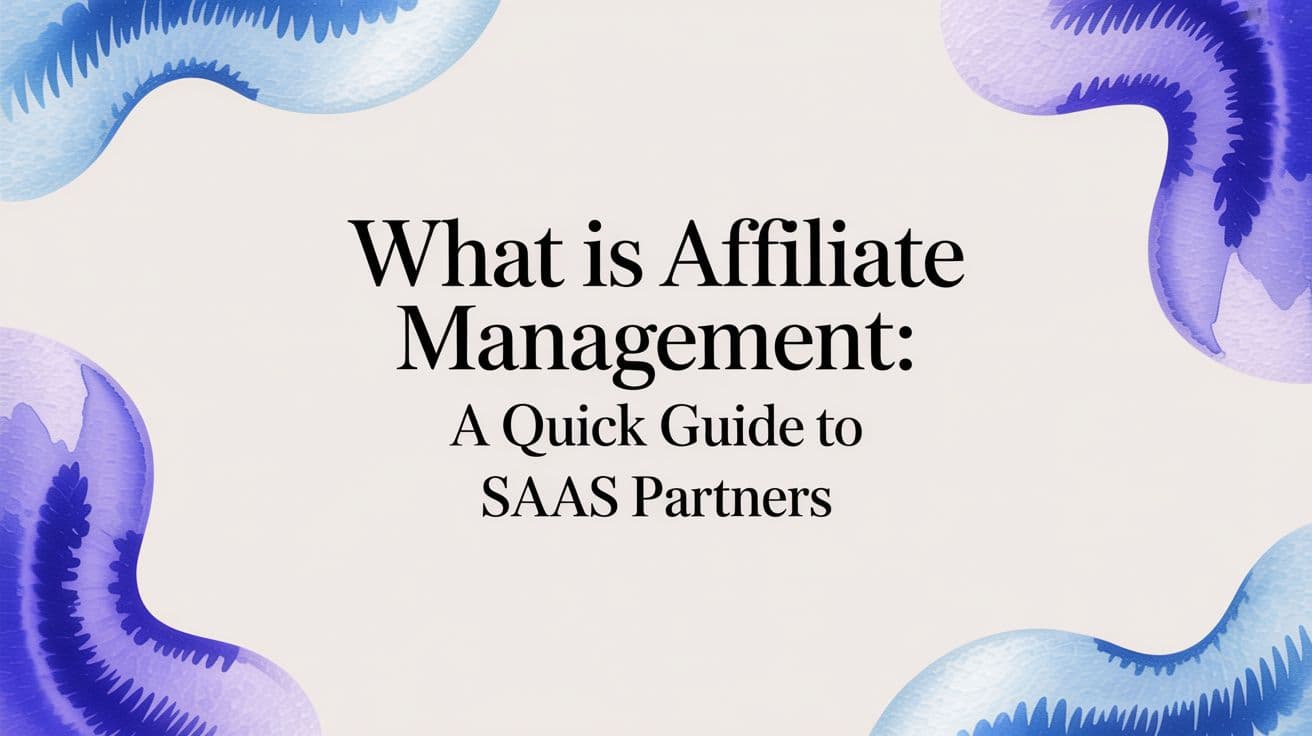what is affiliate management: A quick guide to SaaS partners
Ollie Efez
November 14, 2025•13 min read

So, what exactly is affiliate management?
Think of it less like a passive referral system and more like actively coaching a remote sales team. It’s the hands-on process of building, nurturing, and fine-tuning a network of partners—your affiliates—who promote your SaaS and drive sales.
Understanding Affiliate Management and Its Importance

At its heart, affiliate management is the engine that keeps a partner program running smoothly and growing. For a SaaS company, this means you can't just hand out links and hope for the best. It’s a continuous, strategic effort designed to turn your affiliate program into a predictable and scalable sales channel.
This proactive approach is built on a few core pillars:
- Recruiting the Right Partners: This isn't a numbers game. It's about finding affiliates whose audience genuinely matches your ideal customer profile.
- Providing Essential Tools: You need to arm your partners for success. This means giving them marketing assets, training, and the support they need to promote your product effectively.
- Optimizing Performance: It involves diving into the data to see what’s working, helping your top performers do even better, and coaching the ones with clear potential.
- Building Strong Relationships: The best programs are built on trust and communication. Fostering loyalty keeps your partners engaged and motivated for the long haul.
Getting this right has never been more important. The global affiliate marketing industry is on a massive growth trajectory, set to expand from $18.5 billion in 2025 to a staggering $31.7 billion by 2031. In a market that big, solid management is what separates a thriving program from one that just limps along.
Ultimately, it’s the difference between having a simple referral link floating around and building a dedicated, performance-driven growth engine for your brand. If you need a refresher on the fundamentals, take a look at our guide on the basics of affiliate marketing.
The Building Blocks of a Strong Affiliate Program
A great affiliate program doesn't just happen by accident. It's built piece by piece, with careful attention to a few core elements. Think of it like building a house—you can't just throw up some walls and call it a day. You need a solid foundation, a sturdy frame, and a clear plan.
At its heart, every program involves three key players:
- The Merchant: That's you—the SaaS company with the awesome product. You're the one paying out commissions for new customers.
- The Affiliate: This is your partner. They could be a blogger, a popular YouTuber, or another business that promotes your product to their audience.
- The Customer: The person who finds your product through an affiliate's recommendation, clicks their link, and signs up.
The Tech That Holds It All Together
So, how do you actually connect a customer clicking a link on some blog to a sale on your website? That's where the magic of technology comes in.
Affiliate tracking software is the command center for your entire program. It’s what creates unique referral links for each partner, keeps an eye on every click, and makes sure conversions are credited to the right person. Without it, you'd be flying blind, and partners wouldn't trust that they're getting paid fairly.
Running an affiliate program without solid tracking software is like trying to manage a sales team without a CRM. You might close a few deals, but you'll have no clue who your top performers are or what's actually working.
Setting the Rules of the Game
Finally, you need a clear agreement that holds the whole partnership together. This is all about your commission structure and program terms.
Your commission structure is simple: it's how your affiliates get paid. Maybe it's a percentage of the first sale or a flat fee for every new trial signup. This needs to be crystal clear.
Just as important are the program terms. This is your rulebook. It spells out what affiliates can and can't do to promote your product. Getting these details right from day one is the key to building lasting, trustworthy relationships. If you're ready to lay that groundwork, our guide on how to set up an affiliate program is the perfect place to start.
The Four Pillars of Daily Affiliate Management
Great affiliate management isn't a one-and-done task. It's a daily rhythm, a continuous cycle of activities that keeps your program healthy and growing. The day-to-day grind can be broken down into four critical pillars: Recruitment, Activation, Optimization, and Compliance.
Think of it like tending a garden. You don't just toss some seeds out and hope for the best. You have to carefully pick the right plants, give them the water and sunlight they need to grow, prune them to get a better harvest, and pull the weeds.
Find the Right Partners with Recruitment
The first pillar, Recruitment, is all about quality, not quantity. Having a massive list of affiliates who aren't the right fit won't move the needle. The real goal is to find and attract partners whose audience is a mirror image of your perfect SaaS customer.
This means you're actively looking for bloggers, YouTubers, and influencers who are already trusted experts in your space. One fantastic partner who really gets your product can send more high-quality leads your way than a hundred random affiliates combined.
Equip Partners for Success Through Activation
Once a new partner is on board, the Activation phase kicks in. This is so much more than just firing off a welcome email with their affiliate link. Activation is all about proper onboarding—giving them the tools, knowledge, and confidence to start promoting your product effectively from day one.
You need to set them up with:
- Marketing Assets: Polished banners, ready-to-use email copy, and slick product screenshots.
- Product Knowledge: Easy-to-understand guides or a quick walkthrough of your SaaS tool's best features.
- Clear Guidance: A simple playbook with promotion strategies and best practices.
An unequipped affiliate is an inactive affiliate. The whole point of activation is to get rid of any and all roadblocks between them signing up and earning their first commission.
Drive Growth with Ongoing Optimization
Optimization is where the magic really happens. This is how you take a program that’s doing okay and turn it into a revenue-generating powerhouse. It involves getting your hands dirty with data to see what’s working, what’s not, and why. You'll dig into the numbers to help your top performers do even better and give a little nudge to those who have potential but aren't quite there yet.
To really get this right, you have to track the key digital marketing performance metrics. This is the only way to spot what’s clicking and where you can make improvements.
This diagram shows how all the pieces of an affiliate program fit together, linking the software, the merchant (that's you!), the affiliate, and the customer.

As you can see, the affiliate software is the engine in the middle, making it possible for you and your affiliates to connect and ultimately bring in new customers.
Protect Your Brand with Compliance
Last but not least, Compliance is your brand's bodyguard. This is all about making sure every single partner plays by the rules—both your program's terms and general marketing regulations.
It’s about stopping things like spammy promotions or misleading claims before they can hurt your reputation. This protects the integrity of your program and ensures it stays healthy for the long haul.
How Great Management Drives Real Business Growth
Putting real effort into affiliate management isn't just another line item on your budget. Think of it as a strategic investment—one that pays off big time. This isn't just about cutting commission checks; it's about building a powerful growth engine that transforms a simple referral link into a predictable revenue stream.
At its heart, affiliate management is one of the most cost-effective ways to get new customers. Forget paying for ads and hoping for the best. With affiliates, you only pay for actual results, like a new paid subscriber. This performance-based model keeps your financial risk incredibly low.
Expanding Your Reach and Authority
But the benefits go way beyond just sales. A well-run program is a secret weapon for building brand authority. When respected creators and industry experts recommend your SaaS, it creates a level of trust that no banner ad can ever match. It’s powerful social proof.
This strategy also puts your brand in front of entirely new audiences that you'd struggle to reach on your own. It’s like getting a VIP pass into established communities, whether they're in a new country or a niche you haven't cracked yet, all without the massive upfront cost of a traditional marketing blitz.
The scale here is staggering. Affiliate marketing now drives about 16% of all e-commerce sales. By 2025, that number is expected to balloon, accounting for over $210 billion in U.S. e-commerce sales alone. You can find more stats on the growth of affiliate marketing on hostinger.com.
It’s this kind of consistent growth that has top SaaS companies treating their partner programs as a core part of their strategy. They've seen the compounding effect of strategic affiliate channels and how it fuels faster, more efficient growth. To really get the most out of it, applying solid marketing automation best practices is key to making sure your efforts can scale without everything falling apart.
Navigating Common Affiliate Program Challenges

Running a killer affiliate program can feel like a superpower for growth, but let's be real—it's not always smooth sailing. Getting ahead of the curve means spotting the common pitfalls before they trip you up.
Just like any other marketing channel, this one has its own set of quirks and challenges. The big three that almost everyone runs into are affiliate fraud, the never-ending hunt for good partners, and the tough job of keeping them in the game for the long haul.
If you ignore these issues, you're just burning cash and leaving money on the table. A hands-on approach is your best bet to keep things running right.
Tackling Fraud and Low-Quality Traffic
One of the biggest headaches you'll face is affiliate fraud. This isn't just one thing; it can be anything from cookie stuffing (sneaking tracking cookies onto a user's browser without their knowledge) to sending you a flood of fake leads just to pocket a commission. It’s a constant battle that can completely poison your results.
The trick is to stop playing defense and start playing offense. Good affiliate management software will have fraud detection tools baked right in, flagging sketchy behavior as it happens.
Think of fraud detection as your program's immune system. It works quietly in the background, spotting and stopping threats before they can do any real damage to your program’s health or your company's reputation.
Recruiting the Right Partners
Finding and signing up high-quality affiliates is another constant grind. Sure, you can get hundreds of sign-ups from generic coupon sites in a day, but that’s not the goal. The real challenge is finding those key partners who have a real, engaged audience that actually cares about what you're selling.
The best way to fix this is by creating a detailed ideal partner persona. Think of it as a profile of your perfect affiliate—what's their niche? Who is their audience? What's their content like? Once you have this clear picture, your recruiting efforts become laser-focused and way more successful.
Keeping Affiliates Engaged and Motivated
Even your all-star affiliates can go cold if you don't keep them fired up. Keeping them actively promoting your SaaS takes consistent work. An affiliate who was crushing it last quarter could easily go silent without regular check-ins and new reasons to stay excited.
You have to build some momentum and keep it going. Here’s how:
- Tiered Commissions: Give your top performers a raise. As they hit bigger sales goals, bump up their commission rates.
- Performance Bonuses: Throw in some one-time bonuses for hitting specific targets, like driving 50 new trials in a single month.
- Regular Communication: Don't let them forget about you. Send out newsletters with new marketing materials, product news, and insider tips.
This kind of proactive thinking about what is affiliate management is what turns potential problems into a stronger, more profitable program.
Frequently Asked Questions About Affiliate Management
Stepping into affiliate marketing can feel like learning a new language. You've probably got a few questions buzzing around. Let's clear up some of the most common ones.
What’s the Difference Between Affiliate Marketing and Affiliate Management?
It’s easy to mix these two up, but they’re really two sides of the same coin.
Think of affiliate marketing as the big idea. It’s the game plan: you partner with people who promote your product, and you pay them a commission for the customers they send your way. It’s the "what."
Affiliate management is all about execution. It's the hands-on work of bringing that game plan to life. This is the "how"—the day-to-day grind of finding the right partners, getting them set up, tracking their results, and building real relationships to help everyone win.
Can I Manage an Affiliate Program Myself?
You absolutely can, especially when you’re just getting your feet wet. For a new program, one person equipped with good affiliate software can definitely handle the basics like recruiting your first batch of partners and keeping an eye on their performance.
But be warned: as your program gets bigger, the work involved grows exponentially. Juggling hundreds of partners, fine-tuning campaigns, and making sure everyone gets paid on time can easily turn into a full-time job. This is the point where most growing SaaS companies either hire a dedicated affiliate manager or bring in an agency to handle the heavy lifting.
How Much Should I Pay My Affiliates?
This is the golden question, and there's no magic number that fits everyone. For SaaS, the most popular and effective model is a recurring commission. Typically, this means the affiliate gets a cut, often around 20-30%, of every subscription payment for as long as their referred customer stays with you.
A recurring commission is a game-changer. It gets your affiliates thinking about long-term value, not just quick sign-ups. They’re motivated to find you loyal customers, which means less churn and higher lifetime value for you.
Of course, there are other ways to do it. You could offer a one-time flat fee per new customer or a bigger commission on the first year's contract value. The right choice really comes down to your business model, your margins, and what your competitors are doing.
Still have questions? We've put together a few more common queries to help you get a clearer picture of affiliate management. Hopefully, these answers give you a solid foundation to build on.
Ready to turn your partners into a powerful growth engine? LinkJolt gives you all the tools you need to launch, manage, and scale a successful affiliate program, from automated payouts to real-time analytics. Get started with LinkJolt today and see how easy building a winning program can be.
Ready to supercharge your affiliate marketing?
Join LinkJolt today and get 50% off for the first 3 months with our special promo code.
LINKJOLT50
Sign up and apply code at checkout.